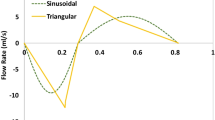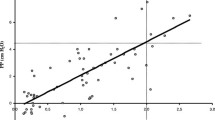Abstract
Despite the increased use of high flow nasal cannula therapy, little has been done to predict airway pressures for a full breath cycle. A 3-month-old infant in vitro model was developed, which included the entire upper airway and the first three bifurcations of the lungs. A breathing simulator was used to create a realistic breath pattern, and high flow was provided using a Vapotherm unit. Four cannulas of varying sizes were used to assess the effects of the inner diameter and nasal occlusion of the cannulas on airway pressures. At 8 L min−1, end expiratory pressures of 0.821–1.306 cm H2O and 0.828–1.133 cm H2O were produced in the nasopharynx and trachea, respectively. Correlations were developed to predict full breath cycle airway pressures, based on the gas flow rate delivered, cannula dimensions, as well as the breathing flow rate, for the nasopharynx and trachea. Pearson correlation coefficients for the nasopharynx and trachea correlations were 0.991 and 0.992, respectively. The developed correlations could be used to determine the flow rate necessary for a cannula to produce pressures similar to CPAP settings. The proposed correlations accurately predict the regional airway pressure up to and including 7 cm H2O of support for the entire breath cycle.






Similar content being viewed by others
References
Bailes, S. A., K. S. Firestone, D. K. Dunn, N. L. McNinch, M. F. Brown, and T. A. Volsko. Evaluating the effect of flow and interface type on pressures delivered with bubble CPAP in a simulated model. Respir. Care 61:333–339, 2016.
Beggs, S., Z. H. Wong, S. Kaul, K. J. Ogden, and J. A. E. Walters. High-flow nasal cannula therapy for infants with bronchiolitis. Cochrane Database Syst. Rev. 2014. https://doi.org/10.1002/14651858.cd009609.pub2.
Bergeson, P. S., and J. C. Shaw. Are infants really obligatory nasal breathers? Clin. Pediatr. (Phila) 40:567–569, 2001.
Chang, G. Y., C. A. Cox, and T. H. Shaffer. Nasal cannula, CPAP, and high-flow nasal cannula: effect of flow on temperature, humidity, pressure, and resistance. Biomed. Instrum. Technol. 45:69–74, 2011.
Chilton, H. W., and J. G. Brooks. Pharyngeal pressures in nasal CPAP. J. Pediatr. 94:808–810, 1979.
De Paoli, A. G., R. Lau, P. G. Davis, and C. J. Morley. Pharyngeal pressure in preterm infants receiving nasal continuous positive airway pressure. Arch. Dis. Child. Fetal Neonatal Ed. 90:79–81, 2005.
Dewan, N. A., and C. W. Bell. Effect of low flow and high flow oxygen delivery on exercise tolerance and sensation of dyspnea: a study comparing the transtracheal catheter and nasal prongs. Chest 105:1061–1065, 1994.
Dysart, K., T. L. Miller, M. R. Wolfson, and T. H. Shaffer. Research in high flow therapy: mechanisms of action. Respir. Med. 103:1400–1405, 2009.
Fleming, S., M. Thompson, R. Stevens, C. Heneghan, A. Plüddemann, I. MacOnochie, L. Tarassenko, and D. Mant. Normal ranges of heart rate and respiratory rate in children from birth to 18 years of age: a systematic review of observational studies. Lancet 377:1011–1018, 2011.
Fontanari, P., H. Burnet, M. C. Zattara-Hartmann, and Y. Jammes. Changes in airway resistance induced by nasal inhalation of cold dry, dry, or moist air in normal individuals. J. Appl. Physiol. 81:1739–1743, 1996.
Franklin, D., F. E. Babl, L. J. Schlapbach, E. Oakley, S. Craig, J. Neutze, J. Furyk, J. F. Fraser, M. Jones, J. A. Whitty, S. R. Dalziel, and A. Schibler. A randomized trial of high-flow oxygen therapy in infants with bronchiolitis. N. Engl. J. Med. 378:1121–1131, 2018.
Gardner, M., W. Longest, and L. Golshahi. Understanding high-flow nasal cannula noninvasively with an in vitro breathing infant lung model. Crit. Care Med. 44:237, 2016.
Goldman, S. L., E. M. McCann, B. W. Lloyd, and G. Yup. Inspiratory time and pulmonary function in mechanically ventilated babies with chronic lung disease. Pediatr. Pulmonol. 11:198–201, 1991.
Greenspan, J. S., M. R. Wolfson, and T. H. Shaffer. Airway responsiveness to low inspired gas temperature in preterm neonates. J. Pediatr. 118:443–445, 1991.
ICRP. Human Respiratory Tract Model for Radiological Protection. ICRP Publication 66 Ann. ICRP, 1994.
Iyer, N. P., and R. Chatburn. Evaluation of a nasal cannula in noninvasive ventilation using a lung simulator. Respir. Care 60:508–512, 2015.
Lee, J. H., K. J. Rehder, L. Williford, I. M. Cheifetz, and D. A. Turner. Use of high flow nasal cannula in critically ill infants, children, and adults: a critical review of the literature. Intensive Care Med. 39:247–257, 2013.
Leone, T. A. A survey of delivery room resuscitation practices in the United States. Pediatrics 117:e164–e175, 2006.
Levy, S. D., J. W. Alladina, K. A. Hibbert, R. S. Harris, E. K. Bajwa, and D. R. Hess. High-flow oxygen therapy and other inhaled therapies in intensive care units. Lancet 387:1867–1878, 2016.
Mayfield, S., H. Jauncey-Cooke, J. L. Hough, A. Schibler, K. Gibbons, and F. Bogossian. High-flow nasal cannula therapy for respiratory support in children (Review). Cochrane Database Syst. Rev. 2014. https://doi.org/10.1002/14651858.CD009850.pub2.
Milési, C., J. Baleine, S. Matecki, S. Durand, C. Combes, A. R. B. Novais, and G. Combonie. Is treatment with a high flow nasal cannula effective in acute viral bronchiolitis? A physiologic study. Intensive Care Med. 39:1088–1094, 2013.
Milési, C., M. Boubal, A. Jacquot, J. Baleine, S. Durand, M. P. Odena, and G. Cambonie. High-flow nasal cannula: recommendations for daily practice in pediatrics. Ann. Intensive Care 4:1–7, 2014.
Möller, W., G. Celik, S. Feng, P. Bartenstein, G. Meyer, O. Eickelberg, O. Schmid, and S. Tatkov. Nasal high flow clears anatomical dead space in upper airway models. J. Appl. Physiol. 118:1525–1532, 2015.
Moore, C. P., I. M. Katz, G. Caillibotte, W. H. Finlay, and A. R. Martin. Correlation of high flow nasal cannula outlet area with gas clearance and pressure in adult upper airway replicas. Clin. Biomech. 66:66–73, 2019.
Moore, C. P., I. M. Katz, M. Pichelin, G. Caillibotte, W. H. Finlay, and A. R. Martin. High flow nasal cannula: influence of gas type and flow rate on airway pressure and CO2 clearance in adult nasal airway replicas. Clin. Biomech. 65:73–80, 2019.
Morley, C. J., A. J. Thornton, M. A. Fowler, T. J. Cole, and P. H. Hewson. Respiratory rate and severity of illness in babies under 6 months old. Arch. Dis. Child. 65:834–837, 1990.
Mortola, J. P., J. T. Fisher, B. Smith, G. Fox, and S. Weeks. Dynamics of breathing in infants. J. Appl. Physiol. 52:1209–1215, 1982.
Nielsen, K. R., L. E. Ellington, A. J. Gray, L. I. Stanberry, L. S. Smith, and R. M. DiBlasi. Effect of high-flow nasal cannula on expiratory pressure and ventilation in infant, pediatric, and adult models. Respir. Care 2017. https://doi.org/10.4187/respcare.05728.
Shepard, J. W., and C. D. Burger. Nasal and oral flow-volume loops in normal subjects and patients with obstructive sleep apnea. Am. Rev. Respir. Dis. 142:1288–1293, 1990.
Sivieri, E. M., J. S. Gerdes, and S. Abbasi. Effect of HFNC flow rate, cannula size, and nares diameter on generated airway pressures: an in vitro study. Pediatr. Pulmonol. 48:506–514, 2013.
Spence, K. L., D. Murphy, C. Kilian, R. McGonigle, and R. A. Kilani. High-flow nasal cannula as a device to provide continuous positive airway pressure in infants. J. Perinatol. 27:772–775, 2007.
Volsko, T. A., K. Fedor, J. Amadei, and R. L. Chatburn. High flow through a nasal cannula and CPAP effect in a simulated infant model. Respir. Care 56:1893–1900, 2011.
Acknowledgments
The Radiology Center in VCU Main Hospital is acknowledged for providing the CT images. Amber Clark and Paul Clark are acknowledged for printing the in vitro model and the preliminary experimental setup. Dr. Golshahi acknowledges the funding received from VCU as startup and Presidential Research Quest Fund (PeRQ). Dr. Gardner acknowledges discussions with her Fellowship Committee.
Conflict of interest
The authors have no conflicts of interest to declare related to the subject of this manuscript.
Author information
Authors and Affiliations
Corresponding author
Additional information
Associate Editor Merryn Tawhai oversaw the review of this article.
Publisher's Note
Springer Nature remains neutral with regard to jurisdictional claims in published maps and institutional affiliations.
Rights and permissions
About this article
Cite this article
Wilkins, J.V., Gardner, M.T., Walenga, R. et al. Mechanistic Understanding of High Flow Nasal Cannula Therapy and Pressure Support with an In Vitro Infant Model. Ann Biomed Eng 48, 624–633 (2020). https://doi.org/10.1007/s10439-019-02377-z
Received:
Accepted:
Published:
Issue Date:
DOI: https://doi.org/10.1007/s10439-019-02377-z




